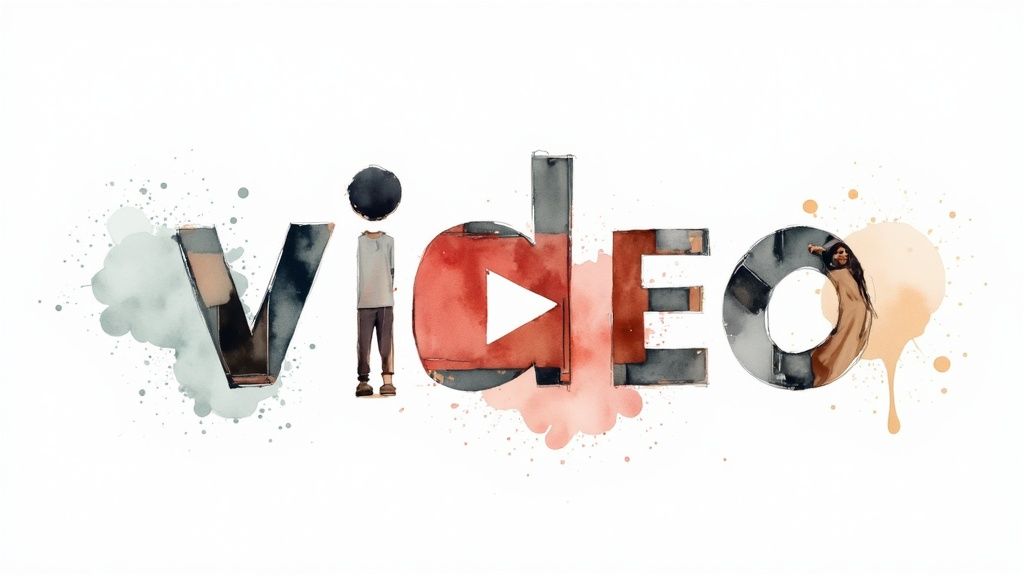Why Video In Text Is Revolutionizing Modern Content

Grabbing and keeping your audience's attention is harder than ever. That's where the impact of video in text shines. It's more than just dropping a video into an article. It's about strategically combining these two mediums to create content that's richer and more captivating. This approach recognizes how people consume information today: they want dynamic visuals paired with concise, easy-to-read text.
This blend caters to different learning styles. Some learn best visually, while others prefer reading. By offering both, content becomes accessible and powerful. Imagine explaining a difficult process solely through text. Now, picture how much clearer it is with a short, helpful video embedded within the explanation. This combination allows for deeper understanding and better information retention.
Video's effectiveness is undeniable. Viewers retain about 95% of a message when watching a video, versus just 10% when reading. This underscores the power of video for conveying complex information effectively. What's more, 96% of people say they've watched explainer videos to learn about a product or service, showcasing video's undeniable influence in marketing. For more stats, check out this resource: Video Statistics.
Enhancing Engagement With Video In Text
The advantages go beyond comprehension. Video in text dramatically boosts engagement. Imagine scrolling through a long article. A well-placed video provides a welcome break, re-engaging the reader and encouraging them to keep going. This is crucial in our world of shrinking attention spans.
The Future of Content Creation
Video in text isn't a fad; it represents a fundamental shift in how we create content. Platforms like Aeon are leading this evolution, giving publishers the tools to seamlessly integrate video into their written content. This creates a smooth transition between text and dynamic visuals, making a more immersive and impactful experience.
This hybrid approach is quickly becoming the standard for effective communication, changing how we share and absorb information. By embracing video in text, creators can connect with audiences on a deeper level, leading to improved comprehension, higher engagement, and ultimately, more valuable interactions.
Mastering Video in Text Integration: Best Practices

Integrating video within your text effectively involves more than just embedding it. It's about creating a synergistic relationship where both mediums enhance each other. This section explores how to achieve this seamless integration, making your content more engaging and informative.
Strategic Video Placement For Optimal Flow
Video placement is critical. A well-placed video can captivate readers, while a poorly placed one can disrupt the flow. For instance, a summary video at the beginning can grab attention. A demonstration video embedded within a relevant section can clarify complex processes. This strategic placement ensures the video complements, not competes with, the text.
Check out our guide on How to create video content for social media for more on content strategies.
To understand optimal placement strategies, let's look at a comparison of different approaches:
The following table, "Video in Text Placement Strategies," compares different approaches to positioning videos within text-based content to help you determine the most effective strategy.
| Placement Strategy | Best Used For | User Engagement | Content Flow Impact | Technical Considerations |
|---|---|---|---|---|
| Beginning of article | Introducing the topic, summarizing key points | High initial engagement | Can be disruptive if too long | Ensure fast load times |
| Within related text section | Demonstrating a process, clarifying complex information | High relevance and engagement | Enhances understanding, minimal disruption | Consider video length and placement within the text |
| End of article | Summarizing key takeaways, providing additional resources | Reinforces learning, encourages further exploration | Can be overlooked if not compelling | Consider using a call to action |
| Interstitial/pop-up | Promoting related content, special offers | Can be highly engaging but also intrusive | High potential for disruption | Careful implementation is crucial to avoid negative user experience |
The table highlights the varying impacts of different video placements. Beginning placement offers high initial engagement, while within-text placement clarifies information. End placement reinforces learning, and interstitial placement, while potentially intrusive, can promote related content. Choosing the right strategy depends on your specific content goals.
Responsive Design For Seamless Viewing
Ensuring your video displays correctly on all devices is paramount. Responsive design is essential, especially with the increasing use of mobile devices. The video player should automatically adjust to fit any screen size, providing a consistent viewing experience.
Addressing Technical Challenges For Enhanced User Experience
Technical aspects are crucial for user satisfaction. Load times, autoplay, and accessibility require careful attention. Slow loading videos frustrate users, while unexpected autoplay can be disruptive. Captions and transcripts improve accessibility and cater to different learning styles. Addressing these issues upfront ensures a smooth, enjoyable experience.
Advanced Strategies For Distinctive Content
Advanced techniques can elevate your video integration. Contextual embedding, linking videos directly to the surrounding text, enhances understanding. Synchronized text-video narratives, where the text highlights corresponding video points, create a more immersive experience. These strategies set your content apart.
Platform-Specific Optimizations For Maximum Impact
Different platforms have unique characteristics. Optimize your strategy by considering video length, aspect ratio, and captioning best practices specific to each platform. Short, engaging videos work well on social media, while longer videos suit educational websites. Tailoring your approach maximizes impact and audience engagement.
Converting Audiences With Video in Text Marketing

Smart brands are seeing the potential of video within text-based marketing to achieve real results. It's not just about boosting engagement; it's about directly improving key performance indicators and driving conversions. This means businesses can use video to guide potential customers through each step of the buying journey.
From Awareness to Decision: Guiding Prospects With Video in Text
Video excels at nurturing leads. A short explainer video embedded in a blog post, for example, can highlight product benefits during the awareness stage.
Product demonstration videos within the text can then persuade prospects in the consideration phase. Finally, customer testimonial videos provide the social proof often needed to seal the deal in the decision stage. This approach effectively guides prospects through the sales funnel.
The rise of video marketing demonstrates its impact. By 2025, 89% of businesses will use video marketing, with 93% of marketers reporting a positive return on investment. For more detailed statistics, check out this resource: 2025 Video Marketing Statistics.
Maintaining Brand Consistency Across Mediums
Maintaining a consistent brand voice across all content is vital for building a strong brand identity. This means ensuring messaging, tone, and visuals in your videos align with your overall brand guidelines.
This cohesion creates a unified experience for your audience, no matter the content format. Using the same brand colors and fonts in your videos and surrounding text, for instance, creates visual harmony.
Measuring the ROI of Video in Text
Measuring the ROI of video in text marketing is crucial. This means tracking metrics like time on page, click-through rates, and conversion rates.
Analyzing audience engagement with embedded videos, including view counts and completion rates, offers valuable insights into what content resonates. This data helps optimize future video content for maximum impact.
Practical Frameworks for Implementation
Successful video in text marketing needs a strategic approach to planning, production, and resources. A content calendar that aligns video with written content is essential.
This planning phase also includes budgeting and resource allocation for video production. Establishing clear workflows for content creation and approval streamlines the entire process.
Optimizing Video in Text for Conversions
Optimizing video in text for conversions is a multi-pronged effort. Make sure your videos include clear calls to action, guiding viewers to take the next step, such as visiting a product page or signing up for a newsletter.
A/B test different video placements and formats to see what works best for your audience. Use analytics to track performance, identify areas for improvement, and refine your strategy over time. Through these strategies, businesses can maximize the impact of video in text and reach their marketing goals.
Short-Form Video in Text: Creating Micro-Moments That Matter
The way we absorb information is changing. Short, engaging content is king. Integrating short-form videos directly within text is a powerful way to grab and keep your audience's attention. These micro-moments can re-energize readers, make complex ideas clear, and create truly memorable experiences.
This shift towards short-form video is fueled by platforms like TikTok and Instagram Reels. By 2024, short-form videos are expected to make up 90% of all internet traffic. This is driven by shrinking attention spans, now at an average of just eight seconds. For a deeper dive into these stats, check out: Short-Form Video Statistics. The potential of these bite-sized videos for engagement and reach is clear.
Platform-Specific Strategies For Short-Form Video Success
Every platform has its quirks. Understanding these nuances is vital for tailoring your video in text strategy. Create videos that not only meet the platform's technical needs, but also connect with its audience.
For example, Instagram Reels thrive on visually striking content and trending audio. TikTok loves creative edits and humor. Twitter, meanwhile, uses short-form video for quick news and engaging commentary. Let's look at each platform:
- Instagram: High-quality visuals are key. Use trending music and hashtags. Leverage interactive features like stickers and polls.
- TikTok: Focus on trends. Creative transitions and edits are essential. Incorporate humor and engaging stories.
- Twitter: Keep it concise and informative. Clear messaging is paramount. Use relevant hashtags and engage with replies and mentions.
This tailored approach ensures your short videos spark real interaction, not just another fleeting glance. For more on this topic, see: Top Text-to-Video AI Tools.
Creating Complementary Short Videos That Enhance Your Narrative
Short-form videos should enhance your written content, not just repeat it. They're a chance to show, not just tell. Find creative ways to visually represent your text's main points.
Consider using short videos to:
- Demonstrate a process
- Provide a visual example
- Offer expert commentary
- Share behind-the-scenes glimpses
This creates a multi-faceted content experience that caters to different learning styles and preferences.
Content Atomization: Breaking Down Complex Topics Into Digestible Videos
Content atomization means dividing larger topics into smaller, self-contained units. This is even more effective with short-form video. Think of it as creating bite-sized learning modules.
Each video can focus on one aspect of a broader topic, providing a concise and engaging explanation. This makes complex information easier to grasp and remember. It also creates easily shareable content that can expand your reach across platforms.
Best Practices for Short-Form Video Integration
Creating effective short-form videos requires strategy. Consider these tips:
- Keep it concise: Aim for videos under 60 seconds.
- Prioritize quality: Good lighting and audio are crucial.
- Add captions: This ensures accessibility for everyone, including those watching without sound.
- Include a clear call to action: Guide viewers towards the next step you want them to take.
Following these best practices will maximize your short-form videos' impact and create a more engaging experience for your audience.
The table below provides a comparison of popular platforms for integrating short-form videos within text content. It highlights key features to consider when choosing the best platform for your needs.
Short-Form Video Platform Comparison: Analysis of major platforms for integrating short videos within text content
| Platform | Typical Video Length | Integration Options | Audience Demographics | Content Type Performance |
|---|---|---|---|---|
| Instagram Reels | Up to 90 seconds | In-feed, Stories | Primarily Gen Z and Millennials | High engagement for visually appealing content |
| TikTok | Up to 10 minutes | In-feed | Primarily Gen Z | High virality potential for creative and trending content |
| Up to 2 minutes 20 seconds | In-feed | Diverse, news-focused | Strong performance for short, informative videos |
This table highlights key differences in video length, integration methods, audience demographics, and content performance across platforms. Choosing the right platform depends on your specific goals and target audience.
Building Inclusive Experiences With Video in Text

Creating effective content hinges on reaching everyone in your audience. This means recognizing that people learn and absorb information differently. This section explores how integrating video with text can create a more inclusive experience, accommodating a variety of learning styles and abilities. It's not just about ticking off accessibility requirements; it's about creating content that genuinely serves everyone.
Accessibility Best Practices for Video in Text
Accessible video content within text goes beyond simple checklists. It requires understanding the needs of users with diverse abilities. Captioning is crucial for those with hearing impairments. Captions should be precisely synchronized with the audio and encompass non-speech sounds. Audio descriptions paint a verbal picture for visually impaired users, narrating the on-screen action. Offering full transcripts provides an alternative access point, particularly beneficial for those who prefer reading or have cognitive differences. Together, these elements contribute to a more comprehensive and accessible experience.
You might be interested in: AI Video Editor for Social Media.
Benefits for Diverse Information Processing Styles
The advantages of video within text extend to individuals with varying information processing styles. Some people struggle with dense blocks of text. For them, video provides a more engaging and digestible format for complex information. Others may be visual learners who find videos more effective for grasping new concepts. This integrated approach accommodates these preferences while retaining text for those who learn best by reading. This ensures everyone can access information in the way that best suits their learning style, promoting greater inclusion.
Further emphasizing the value of video in text is the progress of deep learning in sign language translation. The Turkish Sign Language dataset (AUTSL), for instance, boasts 38,336 video samples spanning 226 signs performed by 43 signers. This dataset helps train deep learning models to convert gestures into text. Explore this further: Sign Language Translation Research. The combination of video, text, and AI holds significant implications for accessibility and communication.
Evaluating Content Against WCAG 2.1 Standards
Measuring content against the Web Content Accessibility Guidelines (WCAG) 2.1 is essential for genuine inclusivity. These standards offer a framework for enhancing web content accessibility for people with disabilities. This includes specific criteria for video content, like providing captions and audio descriptions. While WCAG compliance is vital for meeting baseline accessibility requirements, true inclusion goes beyond mere compliance.
Implementing Universal Design Principles
Universal design focuses on creating experiences usable by everyone, regardless of ability. This involves considering accessibility from the outset of content creation, not as a later addition. For video in text, this might involve providing multiple ways to access information, using clear and concise language in both mediums, and ensuring visual clarity and high audio quality. Implementing these principles results in inherently more accessible and enjoyable content for a wider audience. This benefits not just users with disabilities, but also enhances the experience for everyone.
The Future of Video in Text: Emerging Technologies
Current video-in-text strategies are proving effective, but exciting new technologies are on the horizon. This exploration dives into cutting-edge developments set to revolutionize how video and text interact, leading to even more dynamic and engaging content.
AI-Powered Content Creation: Automating the Process
Artificial intelligence (AI) is rapidly transforming content creation. One key area is automatic video summarization. AI can condense long videos into short, easily digestible clips perfect for embedding within text. This saves readers valuable time and delivers key information quickly. Intelligent content recommendations are another significant advancement. AI can analyze text and suggest relevant videos, enriching the reading experience with valuable supplemental information.
Perhaps the most groundbreaking development is real-time video generation from text. This allows creators to instantly produce videos based on written content. This streamlines workflows and unlocks exciting possibilities for dynamic storytelling. Imagine writing a blog post about baking a cake. AI could automatically generate a short video demonstrating key steps, embedded right within the recipe.
This immediate visual aid engages the reader and deepens their understanding.
Augmented Reality: Bridging Physical and Digital
Augmented reality (AR) blurs the lines between physical text and digital video. Imagine holding your smartphone camera over a printed page and seeing video elements overlaid on the text. This interactive experience brings static content to life, offering a richer understanding through dynamic visuals. For educational materials, this could mean videos demonstrating scientific concepts appearing directly over textbook diagrams.
In marketing, AR can enhance product brochures with videos showcasing features and benefits. This technology is reshaping how we interact with both physical and digital content.
Enhanced Connectivity: Seamless Video Integration
Faster internet speeds and improved connectivity allow for seamless high-quality video integration into text. This means less buffering, smoother playback, and more immersive experiences. High-resolution video embedded directly within articles becomes as natural as viewing images. This richer storytelling creates more engaging presentations.
The lines between text, images, and video blur, creating a more fluid and interactive content experience.
Preparing for the Future: Adapting Your Strategy
To harness these emerging technologies, consider the following:
- Experiment with AI Tools: Explore AI-powered video summarization, content recommendations, and generation tools like Aeon to improve your content creation process.
- Explore AR Possibilities: Consider how AR can create interactive experiences for your audience.
- Prioritize High-Quality Video Production: Ensure your video content meets the demands of seamless integration and faster loading times.
- Stay Informed: Keep up with industry trends and emerging technologies to stay at the forefront of video-in-text innovation.
By understanding and adapting to these advancements, you can keep your content strategy effective and engaging.